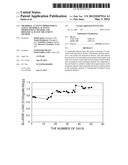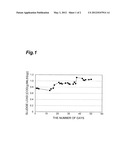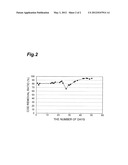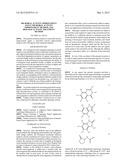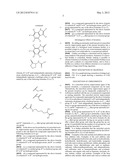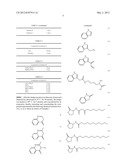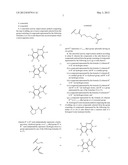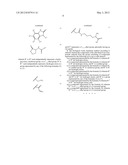Patent application title: MICROBIAL ACTIVITY IMPROVEMENT AGENT, MICROBIAL ACTIVITY IMPROVEMENT METHOD, AND BIOLOGICAL WASTE TREATMENT METHOD
Inventors:
Hideki Inaba (Kanagawa, JP)
Youhei Hashimoto (Kanagawa, JP)
Nobuhiko Nomura (Ibaraki, JP)
Masanori Toyofuku (Ibaraki, JP)
Assignees:
SUMITOMO HEAVY INDUSTRIES, LTD.
IPC8 Class: AC12N138FI
USPC Class:
435244
Class name: Chemistry: molecular biology and microbiology micro-organism, per se (e.g., protozoa, etc.); compositions thereof; proces of propagating, maintaining or preserving micro-organisms or compositions thereof; process of preparing or isolating a composition containing a micro-organism; culture media therefor chemical stimulation of growth or activity by addition of chemical compound which is not an essential growth factor; stimulation of growth by removal of a chemical compound
Publication date: 2012-05-03
Patent application number: 20120107914
Abstract:
A compound selected from the group consisting of 4-quinolone and
derivatives thereof, homoserine lactone derivatives, and indole and
derivatives thereof, and salts thereof have an action of a microbial
activity improvement agent, and when it is used for a microbial activity
improvement method and a biological waste treatment method, the compound
or the salt thereof is useful to achieve the improvement in the treatment
capacity that transcends the limit of improvement in the treatment
capacity of conventional biological waste treatment facilities.Claims:
1. (canceled)
2. (canceled)
3. A microbial activity improvement method comprising the step of adding one or more compounds selected from the group consisting of compounds represented by the following formulae (1) to (4) or salts thereof into an environment where a microorganism exists: ##STR00007## wherein R1 to R6 each independently represents a hydrogen atom, a hydroxyl group, or a C1-6 alkyl group; R7 to R17 each independently represent a hydrogen atom or a group represented by any of the following formulae (5) to (7): ##STR00008## and R18 represents a C9-15 alkyl group optionally having an oxo group.
4. The microbial activity improvement method according to claim 3, wherein the compounds or the salts thereof are compounds selected from the group consisting of compounds represented by the following (a) to (g) or salts thereof: (a) a compound represented by the formula (1) wherein R1 to R6 are hydrogen atoms; (b) a compound represented by the formula (1) wherein R2 to R6 are hydrogen atoms, and R1 is a methyl group; (c) a compound represented by the formula (1) wherein R1 is a methyl group, R2 is a hydroxyl group, and R3 to R6 are hydrogen atoms; (d) a compound represented by the formula (2) wherein R7 to R12 are hydrogen atoms; (e) a compound represented by the formula (2) wherein R7 and R9 to R12 are hydrogen atoms, and R8 is a group represented by any of the formulae (5) to (7); (f) a compound represented by the formula (3) wherein R13 to R17 are hydrogen atoms; and (g) a compound represented by the formula (4) wherein R18 is a C10-15 alkyl group or a 2-oxononyl group.
5. A biological waste treatment method comprising the step of adding one or more compounds selected from the group consisting of compounds represented by the following formulae (1) to (4) or salts thereof into a reaction tank of a biological waste treatment facility: ##STR00009## wherein R1 to R6 each independently represents a hydrogen atom, a hydroxyl group, or a C1-6 alkyl group; R7 to R17 each independently represent a hydrogen atom or a group represented by any of the following formulae (5) to (7): ##STR00010## and R18 represents a C9-15 alkyl group optionally having an oxo group.
6. The biological waste treatment method according to claim 5, wherein the compounds or the salts thereof are compounds selected from the group consisting of compounds represented by the following (a) to (g) or salts thereof: (a) a compound represented by the formula (1) wherein R1 to R6 are hydrogen atoms; (b) a compound represented by the formula (1) wherein R2 to R6 are hydrogen atoms, and R1 is a methyl group; (c) a compound represented by the formula (1) wherein R1 is a methyl group, R2 is a hydroxyl group, and R3 to R6 are hydrogen atoms; (d) a compound represented by the formula (2) wherein R7 to R12 are hydrogen atoms; (e) a compound represented by the formula (2) wherein R7 and R9 to R12 are hydrogen atoms, and R8 is a group represented by any of the formulae (5) to (7); (f) a compound represented by the formula (3) wherein R13 to R17 are hydrogen atoms; and (g) a compound represented by the formula (4) wherein R18 is a C10-15 alkyl group or a 2-oxononyl group. (g) a compound represented by the formula (4) wherein R18 is a C10-15 alkyl group or a 2-oxononyl group.
Description:
TECHNICAL FIELD
[0001] The present invention relates to a microbial activity improvement agent, a microbial activity improvement method, and a biological waste treatment method.
BACKGROUND ART
[0002] As a biological waste treatment technique to purify organic waste (pollutant) such as industrial wastewater, sewage, night soil, leachate, kitchen waste, and animal manure by a microbial degradation potential of organic compounds, an activated sludge method, methane fermentation, and the like are known. In these biological waste treatments, the ability of a biological waste treatment facility is higher as microbial activity involved with decomposition of wastes is higher and the abundance of microorganisms is higher.
[0003] As a method for maintaining a useful microorganism at a high concentration in a reaction tank of a biological waste treatment facility, techniques such as an adhesion carrier method, an entrapping carrier method, a self-granulated sludge method, a biological membrane filtration method, and a membrane bio-reactor are developed (e.g., see Patent Literatures 1 and 2). With the use of these methods, the biological waste treatment can be performed in more compact facilities.
[0004] As another method for increasing microbial concentration, a method in which a microorganism having especially high decomposition activity of a pollutant to be treated is isolated from soil and separately pure-cultured, and then the microorganism is added into a reaction tank is also developed.
[0005] Further, Patent Literature 3 discloses use of a specific compound for adjusting a microbial signaling system.
CITATION LIST
Patent Literature
[0006] Patent Literature 1: Japanese Patent Application Laid-Open Publication No. 8-52486
[0007] Patent Literature 2: Japanese Patent Application Laid-Open Publication No. 2009-66505
[0008] Patent Literature 3: National Publication of International Patent Application No. 2005-517635
SUMMARY OF INVENTION
Technical Problem
[0009] However, since the methods such as the adhesion carrier method, the entrapping carrier method, the self-granulated sludge method, the biological membrane filtration method, and the membrane bio-reactor have a limitation in the increase in microbial concentration within economic constraints, the amount of wastes that is treatable in biological waste treatment facilities is at most about 10 to 30 kg/m3/day in terms of chemical oxygen demand (COD) volume load.
[0010] Further, in the method in which a pure-cultured specific microorganism is added into a reaction tank, the microorganism thus added perishes by the natural selection in the reaction tank in most cases. In view of this, such an attempt that an isolated specific microorganism is formulated into a preparation thin), and is continuously added as appropriate so as to maintain the treatment capacity has been made, but its use application is limited due to economic constraints.
[0011] Although a method in which nutrients are added is conceivable as the method to improve the microbial activity, the addition of a sufficient amount of nutrients means that wastes should be added in large quantities, which impairs the meaning of biological waste treatment facilities and which does not work economically. Addition of minor components such as phosphorus, nitrogen, metal and the like may be carried out in some cases, but the addition does not significantly improve the microbial activity, although the addition provides a preventive effect on a reduction in the microbial activity.
[0012] In view of this, an object of the present invention is to achieve improvement in the treatment capacity of conventional biological waste treatment facilities that transcends the limits of improvement in the treatment capacity.
Solution to Problem
[0013] In one aspect, the present invention provides a microbial activity improvement agent including a compound selected from the group consisting of compounds represented by the following formulae (1) to (4) or a salt thereof:
##STR00001##
wherein R1 to R6 each independently represents a hydrogen atom, a hydroxyl group, or a C1-6 alkyl group; R7 to R17 each independently represent a hydrogen atom or a group represented by any of the following formulae (5) to (7):
##STR00002##
and R18 represents a C9-15 alkyl group optionally having an oxo group.
[0014] By adding an extremely small amount of the above microbial activity improvement agent into a reaction tank of a biological waste treatment facility, it is possible to improve the waste treatment capacity. This accordingly makes it possible to achieve, at a low cost, improvement in the treatment capacity of conventional biological waste treatment facilities that transcends the limit of improvement in the treatment capacity by a conventional method such as an adhesion carrier method, an entrapping carrier method, a self-granulated sludge method, a biological membrane filtration method, a membrane bio-reactor, a method in which a pure-cultured specific microorganism is added into a reaction tank, and a method in which nutrients are added.
[0015] It is more preferable that the microbial activity improvement agent include a compound selected from the group consisting of compounds represented by the following formulae (a) to (g) or a salt thereof:
[0016] (a) a compound represented by the above formula (1) wherein R1 to R6 are hydrogen atoms;
[0017] (b) a compound represented by the above formula (1) wherein R2 to R6 are hydrogen atoms, and R1 is a methyl group;
[0018] (c) a compound represented by the above formula (1) wherein R1 is a methyl group, R2 is a hydroxyl group, and R3 to R6 are hydrogen atoms;
[0019] (d) a compound represented by the above formula (2) wherein R7 to R12 are hydrogen atoms;
[0020] (e) a compound represented by the above formula (2) wherein R7 and R9 to R12 are hydrogen atoms, and R8 is a group represented by any of the above formulae (5) to (7);
[0021] (f) a compound represented by the above formula (3) wherein R13 to R17 are hydrogen atoms; and
[0022] (g) a compound represented by the above formula (4) wherein R18 is a C10-15 alkyl group or a 2-oxononyl group.
[0023] As described later, these compounds can be relatively easily prepared from sludge having a high treatment capacity of a target pollutant. Further, even at a biological waste treatment facility in which the treatment of pollutant has not worked anymore, by adding an extremely small amount of the compounds to its reaction tank, it is possible to recover the waste treatment capacity of the facility, and further to improve the waste treatment capacity. In other words, even under conditions where the waste treatment capacity decreases in general, it is possible to perform high-efficiency and stable waste treatment.
[0024] In another aspect, the present invention provides a microbial activity improvement method including the step of adding one or more of the microbial activity improvement agents described above into a cultural environment of a microorganism (into an environment where a microorganism exists). The environment where a microorganism exists means the following exemplary environments: a culture medium for culturing a microorganism; soil; organic waste such as industrial wastewater, sewage, night soil, leachate, kitchen waste, and animal manure; a reaction tank of a biological waste treatment facility; and an environment where the after-mentioned biofilm can be formed.
[0025] According to this method, it is possible to control, for example, formation of a microbial biofilm. The biofilm is a structure formed of a microorganism, and it is formed such that a microorganism attached to a substrate secretes a secretion called extracellular polysaccharides or EPS (Extracellar Polysaccaride S). For example, in medical treatment, Staphylococcus aureus or the like forms a biofilm in a catheter and a microorganism in the biofilm has high resistance to antibiotics and immunity, which may cause a problem in some cases.
[0026] By improving, for example, the metabolic activity of a microorganism involved with decomposition of a biofilm in an opportunistic infection, it is accordingly possible to obstruct the formation of a biofilm and to cause antibiotics to reach pathogenic bacteria.
[0027] This microbial activity improvement method is applicable to various targets, such as offshore structures and pipelines, which the biofilm formation affects. For example, the method can be applied to a technique for forming minute biofilms on an anode and a cathode of a microbial battery. Further, the method can be applied to a technique for forming a biofilm for prevention of adhesion of large-sized living organisms to an offshore structure.
[0028] In another aspect, the present invention provides a biological waste treatment method including the step of adding one or more of the microbial activity improvement agents described above into sludge of a biological waste treatment facility.
[0029] According to this method, it is possible to achieve, at a low cost, improvement in the treatment capacity of biological waste treatment facilities that transcends the limit of improvement in the treatment capacity by a conventional method.
[0030] In another aspect, the present invention provides use of a compound selected from the group consisting of compounds represented by the following formulae (1) to (4) or a salt thereof for production of a microbial activity improvement agent:
##STR00003##
wherein, R1 to R6 each independently represents a hydrogen atom, a hydroxyl group, or a C1-6 alkyl group; R7 to R17 each independently represent a hydrogen atom or a group represented by any of the following formulae (5) to (7):
##STR00004##
and R18 represents a C9-15 alkyl group optionally having an oxo group.
[0031] In the above use for production of a microbial activity improvement agent, it is more preferable that the compound or the salt thereof be compounds represented by the following formulae (a) to (g):
[0032] (a) a compound represented by the above formula (1) wherein R1 to R6 are hydrogen atoms;
[0033] (b) a compound represented by the above formula (1) wherein R2 to R6 are hydrogen atoms, and R1 is a methyl group;
[0034] (c) a compound represented by the above formula (1) wherein R1 is a methyl group, R2 is a hydroxyl group, and R3 to R6 are hydrogen atoms;
[0035] (d) a compound represented by the above formula (2) wherein R7 to R12 are hydrogen atoms;
[0036] (e) a compound represented by the above formula (2) wherein R7 and R9 to R12 are hydrogen atoms, and R8 is a group represented by any of the above formulae (5) to (7);
[0037] (f) a compound represented by the above formula (3) wherein R13 to R17 are hydrogen atoms; and
[0038] (g) a compound represented by the above formula (4) wherein R18 is a C10-15 alkyl group or a 2-oxononyl group.
Advantageous Effects of Invention
[0039] By adding an extremely small amount of a microbial activity improvement agent of the present invention into a reaction tank of a biological waste treatment facility, it is possible to improve, at a low cost, waste treatment capacity to an extent that is not achievable by a conventional method.
[0040] Further, according to a microbial activity improvement method of the present invention, formation of a microbial biofilm is controlled, thereby making it possible to obstruct formation of a biofilm, to foam minute biofilms on an anode and a cathode of a microbial battery, and to form a biofilm on a surface of an offshore structure so as to prevent adhesion of large-sized living organisms.
BRIEF DESCRIPTION OF DRAWINGS
[0041] FIG. 1 is a graph showing a transition of sludge load.
[0042] FIG. 2 is a graph showing a transition of COD removal ratio.
DESCRIPTION OF EMBODIMENTS
[0043] As a microbial activity improvement agent of the present invention, a commercial compound can be used. Alternatively, the microbial activity improvement agent of the present invention can be chemically synthesized by a well-known method with the use of commercial compounds as starting materials. The microbial activity improvement agent may be compounds represented by the above formulae (1) to (4) or salts thereof, wherein R1 to R6 each independently represents a hydrogen atom, a hydroxyl group, or a C1-6 alkyl group; R7 to R17 each independently represent a hydrogen atom or a group represented by any of the above formulae (5) to (7); and R18 represents a C9-15 alkyl group optionally having an oxo group.
[0044] In the group represented by R1 to R6 in the above formula (1), the C1-6 alkyl group is preferably a linear alkyl group, and particularly preferably a methyl group. Further, in the group represented by R18 in the above formula (4), the C9-15 alkyl group optionally having an oxo group is preferably a linear alkyl group, and when the group has an oxo group, it is preferable that the number of oxo groups be 1 and the group have the oxo group at the 2-position.
[0045] It is further preferable that the microbial activity improvement agent be compounds represented by the following formulae (8) to (21) or salts thereof.
[0046] Examples of the salts include acid addition salts and base addition salts. Examples of the acid addition salts include: halogenated hydroacid salts such as hydrochloride, hydrofluoride, hydrobromate, and hydroiodide; inorganic acid salts such as nitrate, perchlorate, sulfate, phosphate, and carbonate; lower alkylsulfonate salts such as methanesulfonate, trifluoromethanesulfonate, and ethanesulfonate; aryl sulfonates such as benzenesulfonate and p-toluenesulfonate; and organic salts such as fumarate, succinate, citrate, tartrate, oxalate, and maleate. Examples of the base addition salts include: alkali metal salts such as sodium and potassium; alkaline earth metal salts such as calcium and magnesium; and salts with an organic base, such as ammonium salt, guanidine, triethylamine, and dicyclohexylamine.
[0047] Alternatively, the microbial activity improvement agent of the present invention can be prepared in such a manner that a specific microorganism is cultured so as to secrete these compounds in a culture medium, and the compounds are extracted from the culture medium. Examples of the microorganism that secretes the above compounds include Gram-negative bacteria such as Burkholderia, Pseudomonas, Vibrio, Aeromonas, Bacillus, Streptomyces, Streptococcus, and Lactobacillus.
[0048] In the present description, the microbial activity refers to activity that a microorganism decomposes specific waste (pollutant). Improvement in the microbial activity refers to that the ability of microorganisms per unit to decompose a specific pollutant is improved. Further, a decrease in the microbial activity refers to that the ability of microorganisms per unit to decompose a specific pollutant decreases. Examples of the pollutant include: sugars such as glucose and maltose; alcohols such as methanol; aldehydes such as formaldehyde; organic solids such as kitchen waste; starch, protein, ammonia, nitrate, dimethylsulfoxide (DMSO), and the like, but the pollutant is not limited to them.
[0049] Examples of microorganisms on which the microbial activity improvement agent of the present invention effectively acts include Vibrio, Aeromonas, Streptomyces, Streptococcus, Lactobacillus, Alcaligenes, Ralstonia, Achromobacter, Halomonas, Burkholderia, Pseudomonas, Rhodobacter, Paracoccus, Sphingobacterium, Flavobacterium, Acidobacterium, Bacillus, achromobacter, aerobacter, Brevibacterium, Corynebacterium, Comamonas, Micrococcus, Spirillum, Zoogloea, Clostridium, Dehalococcoides, Aminomonas, Geobacter, Desulfuromonas, Desulfovibrio, Syntrophobacter, Staphylococcus, Methanobacterium, Methanospirillum, Methanosarcina, Methanolinea, Methanobrevibacter, and Methanosaeta.
[0050] The concentration of sludge may be represented in terms of MLSS (Mixed liquor suspended solids) in some cases. The measurement of MLSS can be performed by the method described below, for example. At first, a sludge sample is taken into a centrifuge tube, centrifugation is performed at 3,000 rpm for 10 minutes, and then supernatant is removed. Then, water is added to the obtained precipitate and mixed well, centrifugation is performed again and supernatant is removed in the same manner as above. The obtained precipitate is washed and put into an evaporating dish that has been weighted beforehand, and dried in a dryer at 105 to 110° C. for half a day. Subsequently, after standing to cool in a desiccator, the evaporating dish containing the precipitate is weighted. A mass obtained by subtracting a mass of an empty evaporating dish from a measured mass is MLSS.
[0051] COD can be measured, for example, by a method as described in JISK0102. More specifically, potassium dichromate and sulfuric acid are added to waste (a sample) to be measured, and a reflux condenser is set to boil the sample for two hours, followed by finding an amount of dichromic acid consumed and representing the amount by an equivalent amount of oxygen. Alternatively, COD may be measured by a method in accordance with a manual of a maker by use of Potable Spectrophotometer (made by HACH Company, model number DR/2400).
[0052] A biological waste treatment method of the present invention is achievable by further including, in addition to a conventional biological waste treatment method, the step of adding one or more of the microbial activity improvement agents into a reaction tank of a biological waste treatment facility. The microbial activity improvement agent may be added to waste (wastewater) introduced into the reaction tank of the biological waste treatment facility. The microbial activity improvement agent may be added as a compound chemically synthesized, or extract extracted from culture supernatant obtained as a result of culture of a microorganism of the above specified Gram-negative bacteria may be added. The addition concentration per microbial activity improvement agent ranges preferably from 1 nmol/L to 1 mmol/L, further preferably from 10 nmol/L to 100 μmol/L, and particularly preferably 100 nmol/L to 10 μmol/L, in terms of a final concentration in the reaction tank. The microbial activity improvement agent may be added at a concentration of more than 1 mmol/L, but that may be disadvantageous in terms of cost. Further, even if the microbial activity improvement agent is added at a concentration of less than 1 nmol/L, a sufficient microbial activity-improving effect may not be obtained.
[0053] A microbial activity improvement method of the present invention is achievable by including the step of adding, into a cultural environment of a microorganism, the same microbial activity improvement agent as in the biological waste treatment method at a similar concentration.
EXAMPLES
[0054] The following shows examples of the present invention to explain the present invention further in details, but the present invention is not limited to these examples and can be altered variously within a scope that does not deviate from the technical idea of the present invention.
Example 1
Preparation of Extract Including Microbial Activity Improvement Agent
[0055] Sludges were collected from more than 10 Expanded Granular Sludge Bed (EGSB) plants, and they were acclimated in waste (artificial wastewater) of a composition shown in Table 1. Compositions of a solution A, a solution B, and a solution C in Table 1 are respectively shown in Tables 2 to 4. From these sludges, a sludge having the highest methanogenic activity was selected. Evaluation on the methanogenic activity was carried out by a method described in Example 2. Compounds secreted from a microorganism, included in this sludge, were analyzed by liquid chromatograph time-of-flight mass spectrometry (LC-TOF-MS). As a result, it was demonstrated that compounds represented by the following chemical formulae (8) to (21) existed in this sludge. As a result of estimating the concentrations of the respective compounds from a peak area of the LC-TOF-MS, they were hundreds of nanomoles per liter to tens of micromoles per liter.
TABLE-US-00001 TABLE 1 Skim milk 10 g/L NaHCO3 4 g/L K2HPO4 4 g/L NH4Cl 1 g/L KCl 1 g/L Solution A 1 mL/L Solution B 1 mL/L Solution C 1 mL/L
TABLE-US-00002 TABLE 2 Composition of solution A Urea 135 g/L KH2PO4 57 g/L
TABLE-US-00003 TABLE 3 Composition of solution B FeSO4•7H2O 25 g/L MgSO4•7H2O 51 g/L
TABLE-US-00004 TABLE 4 Composition of solution C CaCl2•2H2O 1.0 g/L ZnCl2 0.2 g/L CuCl2•2H2O 0.1 g/L MnCl2•4H2O 0.2 g/L AlCl3 0.2 g/L NiCl2 0.1 g/L
[0056] After this sludge was put in an ultrasonic cleaner and dispersed by ultrasound at 25° C. for 10 minutes, the sludge was heated at 105° C. for 5 minutes and concentrated by an evaporator, thereby extracting and concentrating the compounds represented by the following chemical formulae (8) to (21), so as to obtain an extract of Example 1.
##STR00005## ##STR00006##
Example 2
Evaluation on Methanogenic Activity of Sludge
[0057] The evaluation on the methanogenic activity of sludge was carried out by determining, by RT-PCR, the quantity of mcrA gene encoding methyl coenzyme M reductase, which is an enzyme peculiar to methanogen. The methanogen is a microorganism that synthesizes methane under anaerobic conditions. It was observed that there was about 10 times difference in the abundance of the mcrA gene between the respective sludge samples. A sludge in which the abundance of the mcrA gene was the highest was selected as a sludge of high methanogenic activity.
Example 3
Evaluation on Microbial Activity Improvement Agent)
[0058] Sludge was collected from a domestic EGSB plant and broken sludge was removed with a sieve so that granule sludge was prepared. The granule sludge means sludge in which a microorganism is granulated. The diameter of the granule sludge used in the present example was about 1 to 3 mm. Into this granule sludge, artificial waste (artificial wastewater) of COD of 15000 mg/L, which used glucose as a carbon source, was added, and the granule sludge was acclimated for 2 months under a condition of a sludge load of 0.3 [COD (g)/MLSS (g)].
[0059] By use of the acclimated granule sludge, biological waste treatment was performed with an Upflow Anaerobic Sludge Blanket (UASB) apparatus. The UASB apparatus used herein was in a cylindrical shape having a capacity of 1.5 L, an inner diameter of 60 mm, and a height of 1 m. Into the UASB apparatus, 500 ml of the granule sludge was put and the waste (artificial wastewater) of a composition shown in Table 5 was supplied, and the biological waste treatment was performed. Compositions of a solution A, a solution B, and a solution C in Table 5 are respectively shown in Tables 2 to 4 above.
TABLE-US-00005 TABLE 5 Glucose 15 g/L NH4Cl 1 g/L NaHCO3 4 g/L K2HPO4 4 g/L Yeast extract 0.1 g/L FeSO4•7H2O 0.3 g/L Solution A 1 mL/L Solution B 1 mL/L Solution C 1 mL/L
[0060] The artificial wastewater used for experiments uses glucose as the only carbon source. Therefore, when a sudden load is applied to the granule sludge, the rate of methane fermentation does not catch up with the rate of acid formation, so that lower fatty acids such as butyrate, propionate, and acetic acid accumulate, thereby resulting in that a reduction in pH is caused and the waste treatment capacity decreases. In the present example, in order to intentionally realize a reduced treatment capacity due to a sudden load, a load that was higher than usual was applied. More specifically, generally, a sludge load of about 0.3 to 0.5 [COD (g)/MLSS (g)] is applied, but in the present experiment, a sludge load of about 0.7 to 1.1 [COD (g)/MLSS (g)] was applied as shown in FIG. 1.
[0061] As a result, as shown in FIG. 2, a decrease in the treatment capacity was observed on the 27th day from an initiation of the experiment, and the COD removal ratio fell short of 70%. In FIG. 2, the COD removal ratio shows a ratio (%) of a treated pollutant among the applied load (COD). At this point, the concentrations of the lower fatty acids in treated water after the waste treatment in the UASB apparatus were 1300 mg/L for acetic acid and 1800 mg/L for propionate.
[0062] At a stage that the waste treatment capacity decreased, the extract of Example 1 was added to the artificial wastewater to be supplied to the UASB apparatus. The addition ratio thereof was 10 mL per 1 L of the artificial wastewater.
[0063] As a result of adding the extract of Example 1, remarkable elevation of the microbial activity was observed in about 10 days, and the COD removal ratio reached 90%. After that, even if the sludge load was further increased, the decrease in the microbial activity was not observed, and the COD removal ratio increased to 95%. As shown in FIG. 1, the COD removal ratio before the addition of the extract of Example 1 was about 76 to 88%. Thus, by the addition of the extract of Example 1, the COD removal ratio increased markedly. This result shows that the extract of Example 1 has a remarkable microbial activity-improving effect. The concentrations of the respective compounds represented in the above formulae (8) to (21), which were included in the artificial wastewater, ranged from a few nanomoles per liter to hundreds of nanomoles per liter. Thus, these compounds exhibit a microbial activity-improving effect at a very low concentration. It is what the present inventors found for the first time that in sludge of the biological waste treatment, these compounds are effective for improvement in the waste treatment capacity. Further, in the present example, a waste treatment of 20-50 kg/m3/day was observed, and thus, improvement in the waste treatment capacity was attained.
INDUSTRIAL APPLICABILITY
[0064] By adding an extremely small amount of the microbial activity improvement agent of the present invention into a reaction tank of a biological waste treatment facility, it is possible to achieve, at a low cost, improvement in the waste treatment capacity to an extent that is not achievable by a conventional method.
[0065] Further, according to the microbial activity improvement method of the present invention, formation of a microbial biofilm is controlled, thereby making it possible to obstruct formation of a biofilm, to form minute biofilms on an anode and a cathode of a microbial battery, and to form a biofilm on a surface of an offshore structure so as to prevent adhesion of large-sized living organisms.
User Contributions:
Comment about this patent or add new information about this topic:
| People who visited this patent also read: | |
| Patent application number | Title |
|---|---|
| 20120121545 | Pharmaceutical Composition For Bone Disease Treatment Or Countering Inflammation, Comprising Cartilage Stem Cells As An Active Principle |
| 20120121544 | Method for Efficiently Proliferating and Differentiating Natural Killer Cells from Umbilical Cord Blood |
| 20120121543 | ANTI-MICROBIAL AGENT FROM PAENIBACILLUS SP. AND METHODS AND USES THEREOF |
| 20120121542 | RED-SHIFTED OPSIN MOLECULES AND USES THEREOF |
| 20120121541 | 3,5-DISUBSTITUTED AND 3,5,7-TRISUBSTITUTED-3H-OXAZOLO AND 3H-THIAZOLO[4,5-D]PYRIMIDIN-2-ONE COMPOUNDS AND PRODRUGS THEREOF |

